Combining Four Gaussian Lasers Using Silicon Nitride MMI Slot Waveguide Structure
Abstract
1. Introduction
2. The 4 × 1 Power-Combiner Structure and Theoretical Aspects
3. Simulation Results
4. Conclusions
Author Contributions
Funding
Conflicts of Interest
References
- Zhao, H.; Pinna, S.; Sang, F.; Song, B.; Brunelli, S.T.S.; Coldren, L.A.; Klamkin, J. Highpower indium phosphide photonic integrated circuits. IEEE J. Sel. Top. Quantum Electron. 2019, 25, 1–10. [Google Scholar] [CrossRef]
- Xie, C. Datacenter optical interconnects: Requirements and challenges. In Proceedings of the IEEE Optical Interconnects Conference (OI), Santa Fe, NM, USA, 5–7 June 2017; pp. 37–38. [Google Scholar] [CrossRef]
- Absil, P.; Croes, K.; Lesniewska, A.; De Heyn, P.; Ban, Y.; Snyder, B.; De Coster, J.; Fodor, F.; Simons, V.; Balakrishnan, S.; et al. Reliable 50 Gb/s silicon photonics platform for next-generation data center optical interconnects. In Proceedings of the 2017 IEEE International Electron Devices Meeting (IEDM), San Francisco, CA, USA, 2–6 December 2017; pp. 34.2.1–34.2.4. [Google Scholar] [CrossRef]
- Won, R. Integrating silicon photonics. Nat. Photon 2010, 4, 498–499. [Google Scholar] [CrossRef]
- Lee, B.G.; Rylyakov, A.V.; Green, W.M.J.; Assefa, S.; Baks, C.W.; Rimolo-Donadio, R.; Kuchta, D.M.; Khater, M.H.; Barwicz, T.; Reinholm, C.; et al. Monolithic Silicon Integration of Scaled Photonic Switch Fabrics, CMOS Logic, and Device Driver Circuits. J. Light. Technol. 2014, 32, 743–751. [Google Scholar] [CrossRef]
- El-Fiky, E.; Samani, A.; Patel, D.; Jacques, M.; Sowailem, M.; Plant, D.V. 400 Gb/s O-band silicon photonic transmitter for intra-datacenter optical interconnects. Opt. Express 2019, 27, 10258–10268. [Google Scholar] [CrossRef] [PubMed]
- Cassan, E.; Grillet, C.; Neshev, D.N.; Moss, D.J. Nonlinear integrated photonics. Photonics Res. 2018, 6, NIP1–NIP2. [Google Scholar] [CrossRef]
- Katz, O.; Malka, D. Design of novel SOI 1 × 4 optical power splitter using seven horizontally slotted waveguides. Photonics Nanostruct. Fundam. Appl. 2017, 25, 9–13. [Google Scholar] [CrossRef]
- Almeida, V.R.; Xu, Q.; Barrios, C.A.; Lipson, M. Guiding and confining light in void nanostructure. Opt. Lett. 2004, 29, 1209–1211. [Google Scholar] [CrossRef]
- Kovacevic, G.; Phare, C.; Set, S.Y.; Lipson, M.; Yamashita, S. Ultra-high-speed graphene optical modulator design based on tight field confinement in a slot waveguide. Appl. Phys. Express 2018, 11, 065102. [Google Scholar] [CrossRef]
- Shi, X.; Zhang, J.; Fan, W.; Lu, Y.; Peng, N.; Rottwitt, K.; Ou, H. Compact low-birefringence polarization beam splitter using verticaldual-slot waveguides in silicon carbide integrated platforms. Photonics Res. 2022, 10, A8–A13. [Google Scholar] [CrossRef]
- Steglich, P.; You, K.Y. Silicon-on-insulator slot waveguides: Theory and applications in electro-optics and optical sensing. Emerg. Waveguide Technol. 2018, 187–210. [Google Scholar] [CrossRef]
- Guo, K.; Lin, L.; Christensen, J.B.; Christensen, E.N.; Shi, X.; Ding, Y.; Rottwitt, K.; Ou, H. Broadband wavelength conversion in a silicon vertical-dual-slot waveguide. Opt. Express 2017, 25, 32964–32971. [Google Scholar] [CrossRef]
- Malka, D.; Sintov, Y.; Zalevsky, Z. Design of a 1 ×4 silicon-alumina wavelength demultiplexer based on multimode interference in slot waveguide structures. J. Opt. 2015, 17, 125702. [Google Scholar] [CrossRef]
- Malka, D.; Danan, Y.; Ramon, Y.; Zalevsky, Z. A photonic 1 × 4 power splitter based on multimode interference in silicon-gallium-nitride slot waveguide structures. Materials 2016, 9, 516. [Google Scholar] [CrossRef] [PubMed]
- Nikolaevsky, L.; Shchori, T.; Malka, D. Modeling a 1 × 8 MMI green light power splitter based on gallium-nitride slot waveguide structure. IEEE Photonics Technol. Lett. 2018, 18, 720–723. [Google Scholar] [CrossRef]
- Soldano, L.B.; Smit, M.K.; de Vreede, A.H.; van Uffelen, J.W.M.; Verbeek, B.H.; van Bennekom, P.K.; de Krom, W.H.C.; van Etten, W.C. New all-passive 4 × 4 planar optical phase diversity network. In Proceedings of the Joint Meeting. IOOC ECOC ’91. 17th European Conference on Optical Communication ECOC’91, 8th International Conference on Integrated Optics and Optical Fibre Communication IOOC’91, Paris, France, 9–12 September 1991; Volume 91, pp. 96–99. [Google Scholar]
- Bachmann, M.; Smit, M.K.; Besse, P.A.; Gini, E.; Melchior, H.; Soldano, L.B. Polarization-insensitive low-voltage optical waveguide switch using InGaAsP/InP four-port Mach-Zehnder interferometer. In Optical Fiber Communication Conference; Optica Publishing Group: San Jose, CA, USA, 1993; pp. 32–33. [Google Scholar]
- Soldano, L.B.; Pennings, E.C.M. Optical multi-mode interference devices based on self-imaging: Principles and applications. J. Light. Technol. 1995, 13, 615–627. [Google Scholar] [CrossRef]
- BŁahut, M.; Kasprzak, D. Multimode interference structures-properties and applications. Opt. Appl. 2004, 34, 573–587. [Google Scholar]
- Xu, C.L.; Huang, W.P.; Chaudhuri, S.K.; Chrostowski, J. A full-vectorial beam propagation method for anisotropic waveguides. J. Lightwave Technol. 1994, 12, 1926–1931. [Google Scholar] [CrossRef]
- Selleri, S.; Vincetti, L.; Zoboli, M. Full-vector finite-element beam propagation method for anisotropic optical device analysis. IEEE J. Quantum Electron. 2000, 36, 1392–1401. [Google Scholar] [CrossRef]
- Xu, C.; Hong, X.; Huang, W. Design optimization of integrated BiDi triplexer optical filter based on planar lightwave circuit. Opt. Express 2006, 14, 4675–4686. [Google Scholar] [CrossRef] [PubMed]
- Irace, A.; Breglio, G. All-silicon optical temperature sensor based on Multi-Mode Interference. Opt. Express 2003, 11, 2807–2812. [Google Scholar] [CrossRef] [PubMed]
- Zhang, Y.; Liu, L.; Wu, X.; Xu, L. Splitting-on-demand optical power splitters using multimode interference (MMI) waveguide with programmed modulations. Opt. Commun. 2008, 281, 426–432. [Google Scholar] [CrossRef]
- Hosseini, A.; Kwong, D.N.; Zhang, Y.; Subbaraman, H.; Xu, X.; Chen, R.T. 1xN Multimode Interference Beam Splitter Design Techniques for on-Chip Optical Interconnections. J. Light. Technol. 2011, 17, 510–514. [Google Scholar]
- Tajaldini, M.; Jafri, M.Z.M. Simulation of an Ultra-Compact Multimode Interference Power Splitter Based on Kerr Nonlinear Effect. J. Light. Technol. 2014, 32, 1282–1289. [Google Scholar] [CrossRef]
- Blumenthal, D.J.; Heideman, R.; Geuzebroek, D.; Leinse, A.; Roeloffzen, C. Silicon Nitride in Silicon Photonics. Proc. IEEE 2018, 106, 2209–2231. [Google Scholar] [CrossRef]
- Mu, J.; Vázquez-Córdova, S.A.; Sefunc, M.A.; Yong, Y.; García-Blanco, S.M. A Low-Loss and Broadband MMI-Based Multi/Demultiplexer in Si3N4/SiO2 Technology. J. Light. Technol. 2016, 34, 3603–3609. [Google Scholar] [CrossRef]
- Bucio, T.D.; Khokhar, A.Z.; Mashanovich, G.Z.; Gardes, F.Y. N-rich silicon nitride angled MMI for coarse wavelength division (de)multiplexing in the O-band. Opt. Lett. 2018, 43, 1251–1254. [Google Scholar] [CrossRef] [PubMed]
- Gao, G.; Chen, D.; Tao, S.; Zhang, Y.; Zhu, S.; Xiao, X.; Xia, J. Silicon nitride O-Band (de)multiplexers with low thermal sensitivity. Opt. Express 2017, 25, 12260–12267. [Google Scholar] [CrossRef] [PubMed]
- Xiang, C.; Guo, J.; Jin, W.; Wu, L.; Peters, J.; Xie, W.; Chang, L.; Shen, B.; Wang, H.; Yang, Q.; et al. High-performance lasers for fully integrated silicon nitride photonics. Nat. Commun. 2021, 12, 6650. [Google Scholar] [CrossRef]
- Melloni, A.; Costa, R.; Cusmai, G.; Morichetti, F.; Martinelli, M. Waveguide index contrast: Implications for passive integrated optical components. In Proceedings of the 2005 IEEE/LEOSWorkshop on Fibres and Optical Passive Components, Mondello, Italy, 22–24 June 2005; pp. 246–253. [Google Scholar]
- Samoi, E.; Benezra, Y.; Malka, D. An ultracompact 3 × 1 MMI power-combiner based on Si slot-waveguide structures. Photonics Nanostructures-Fundam. Appl. 2020, 39, 100780. [Google Scholar] [CrossRef]
- Ioudashkin, E.; Malka, D. A Three Demultiplexer C-Band Using Angled Multimode Interference in GaN–SiO2 Slot Waveguide Structures. Nanomaterials 2020, 10, 2338. [Google Scholar] [CrossRef]
- Moshaev, V.; Leibin, Y.; Malka, D. Optimizations of Si PIN diode phase-shifter for controlling MZM quadrature bias point using SOI rib waveguide technology. Opt. Laser Technol. 2021, 138, 106844. [Google Scholar] [CrossRef]
- Sitbon, E.; Ostrovsky, R.; Malka, D. Optimizations of thermo-optic phase shifter heaters using doped silicon heaters in Rib waveguide structure. Photonics Nanostructures-Fundam. Appl. 2022, 51, 101052. [Google Scholar] [CrossRef]
- Jacques, M.; Samani, A.; El-Fiky, E.; Patel, D.; Xing, Z.; Plant, D.V. Optimization of thermo-optic phase-shifter design and mitigation of thermal crosstalk on the SOI platform. Opt. Express 2019, 27, 10456–10471. [Google Scholar] [CrossRef] [PubMed]
- Kojima, K.; Koike-Akino, T. Novel multimode interference devices for wavelength beam splitting/combining. In Proceedings of the 2015 International Conference on Photonics in Switching, Florence, Italy, 22–25 September 2015; pp. 34–36. [Google Scholar]
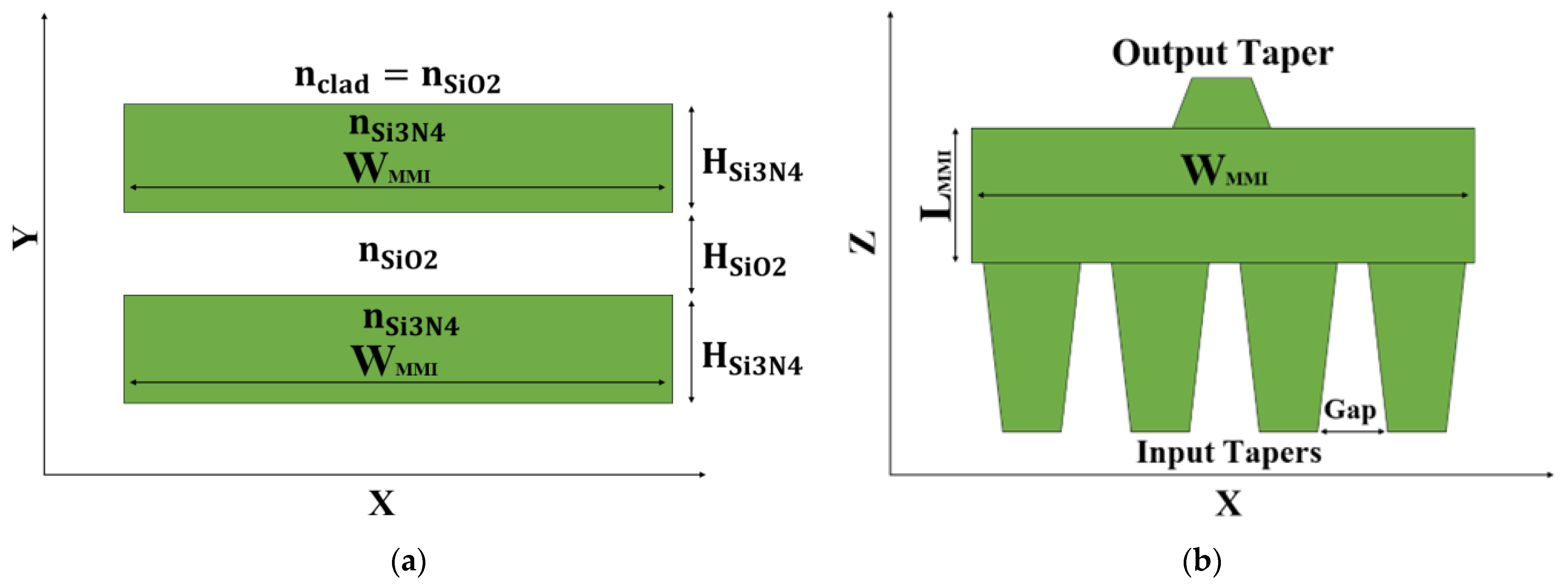
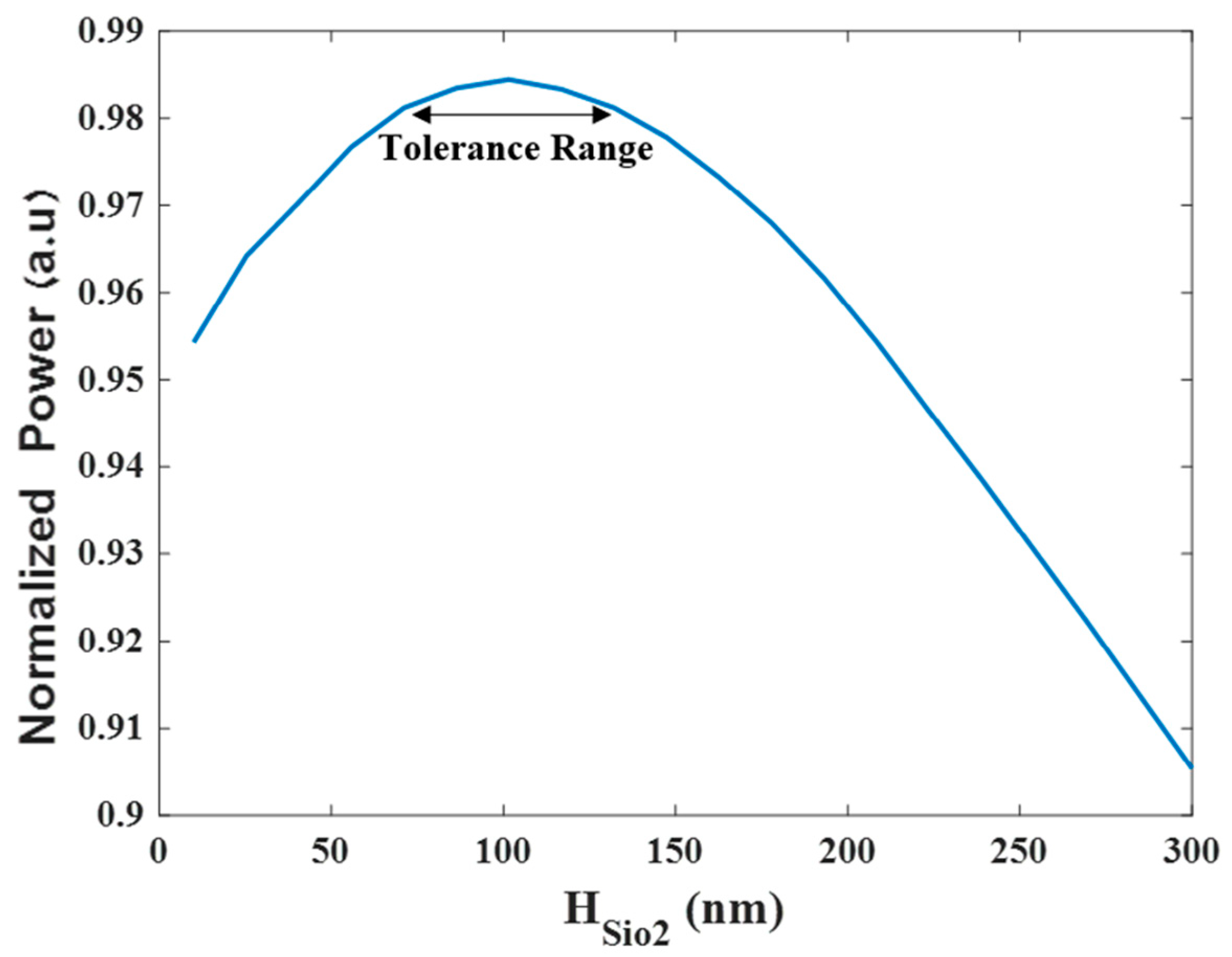


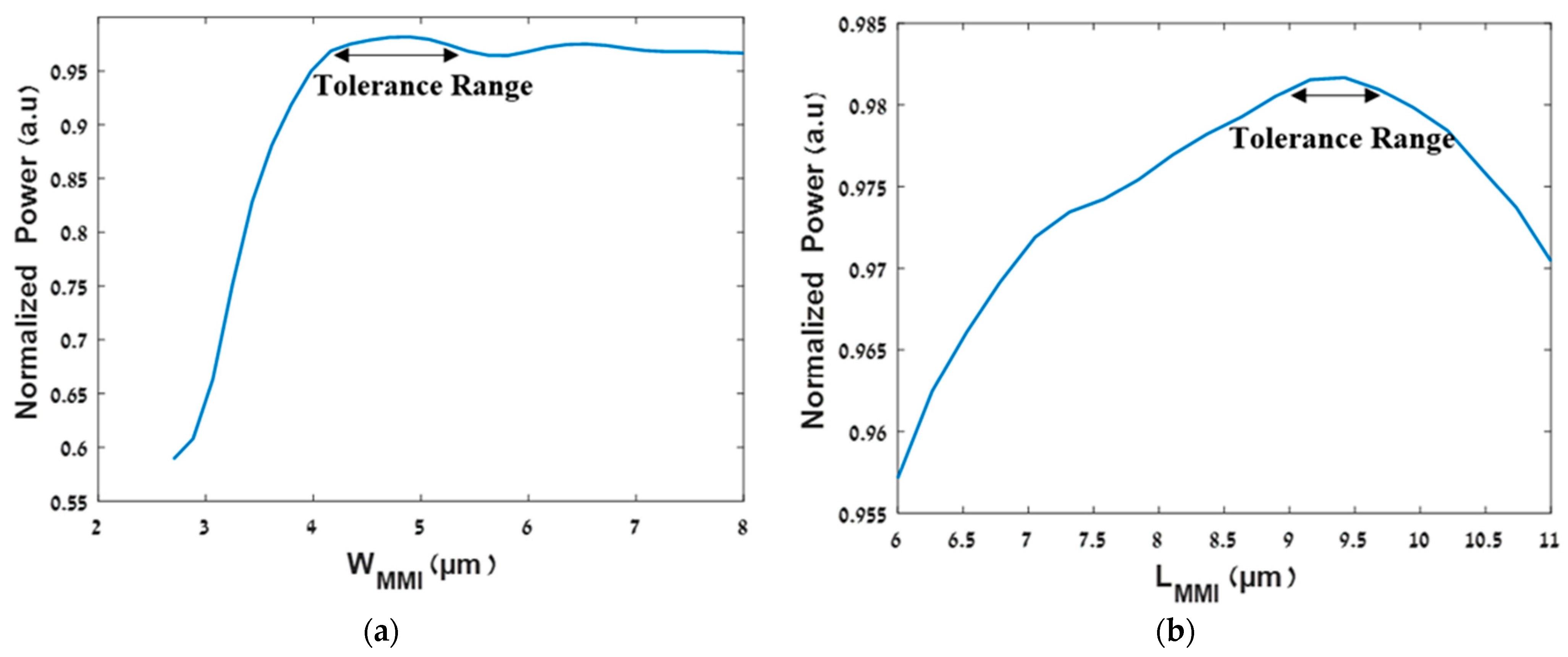
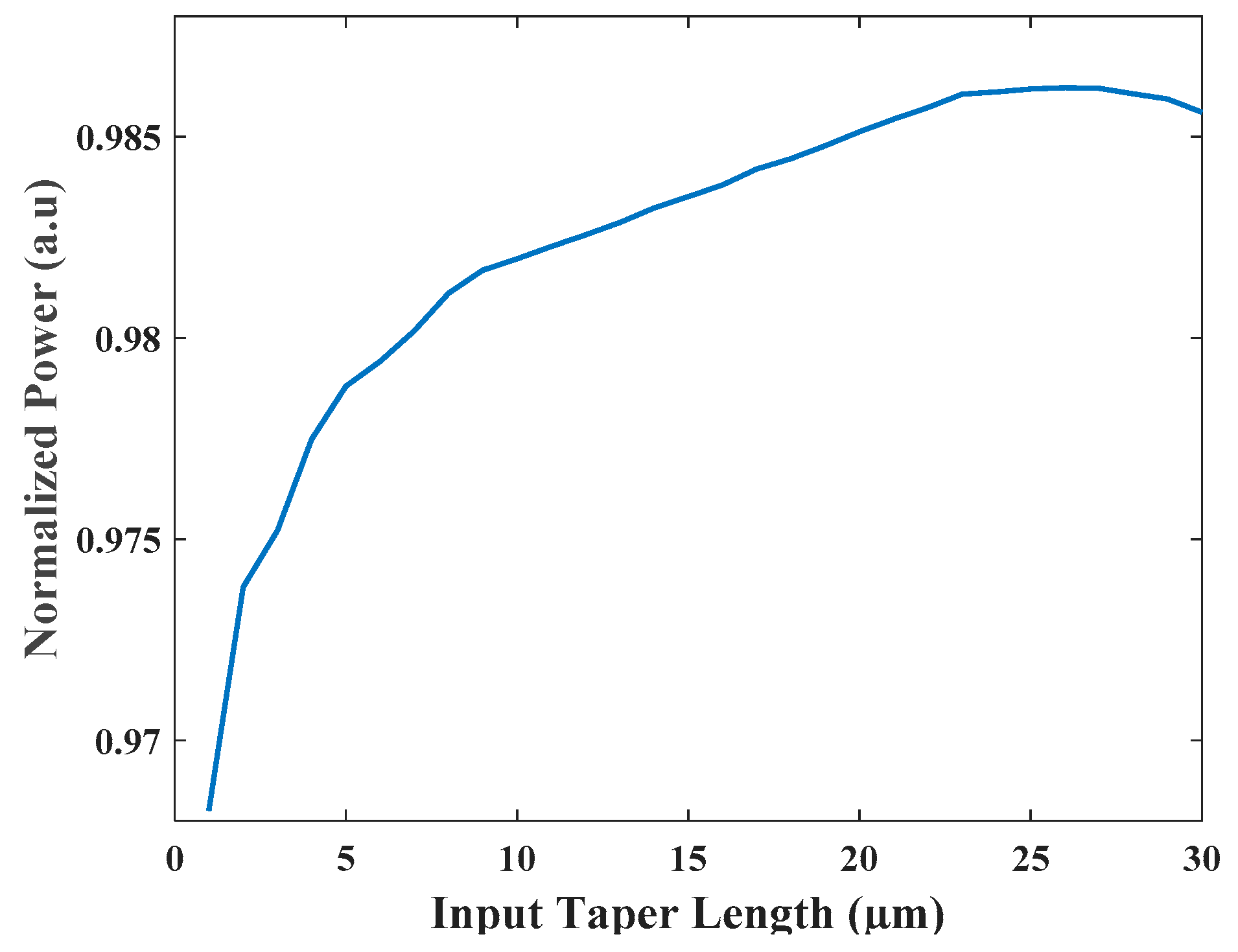
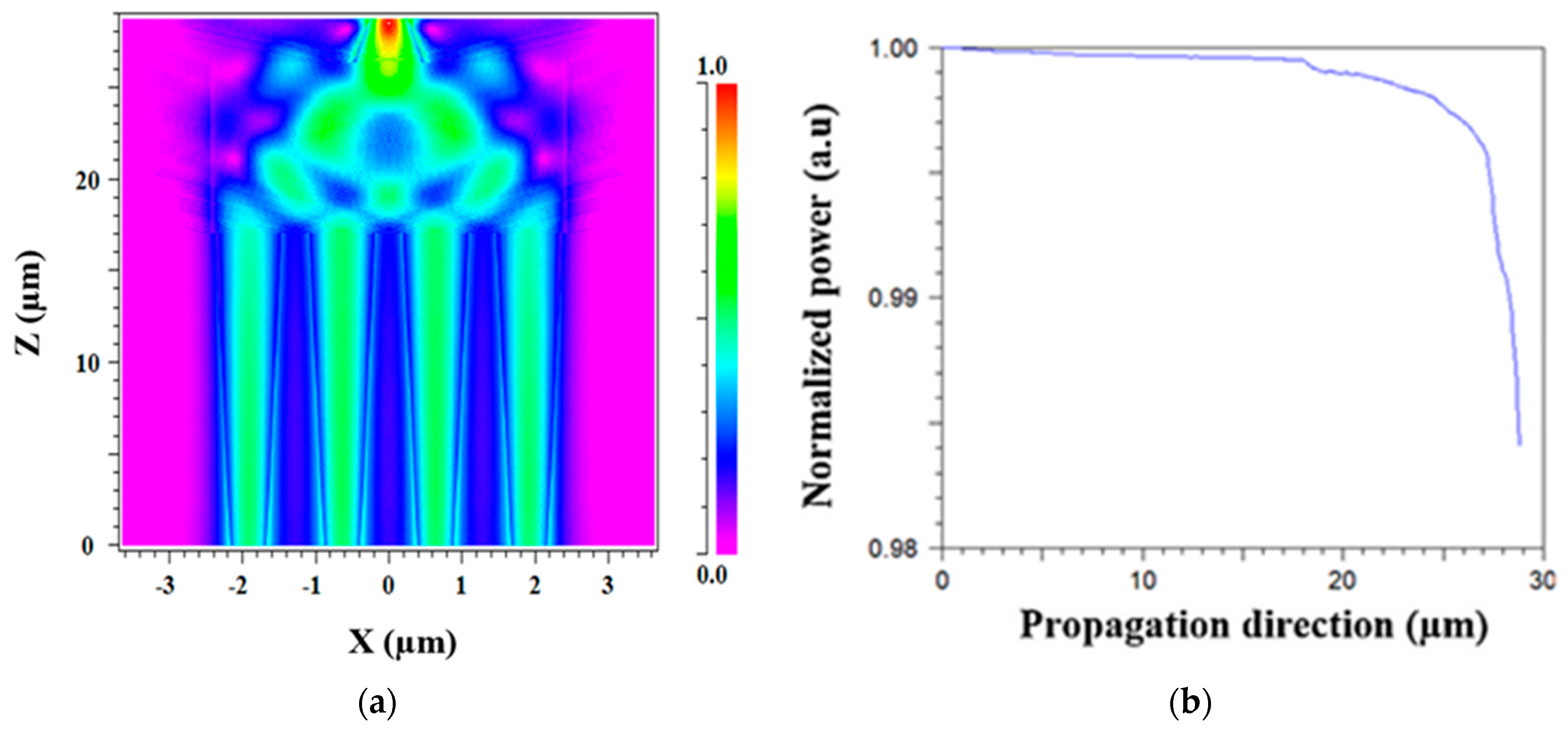

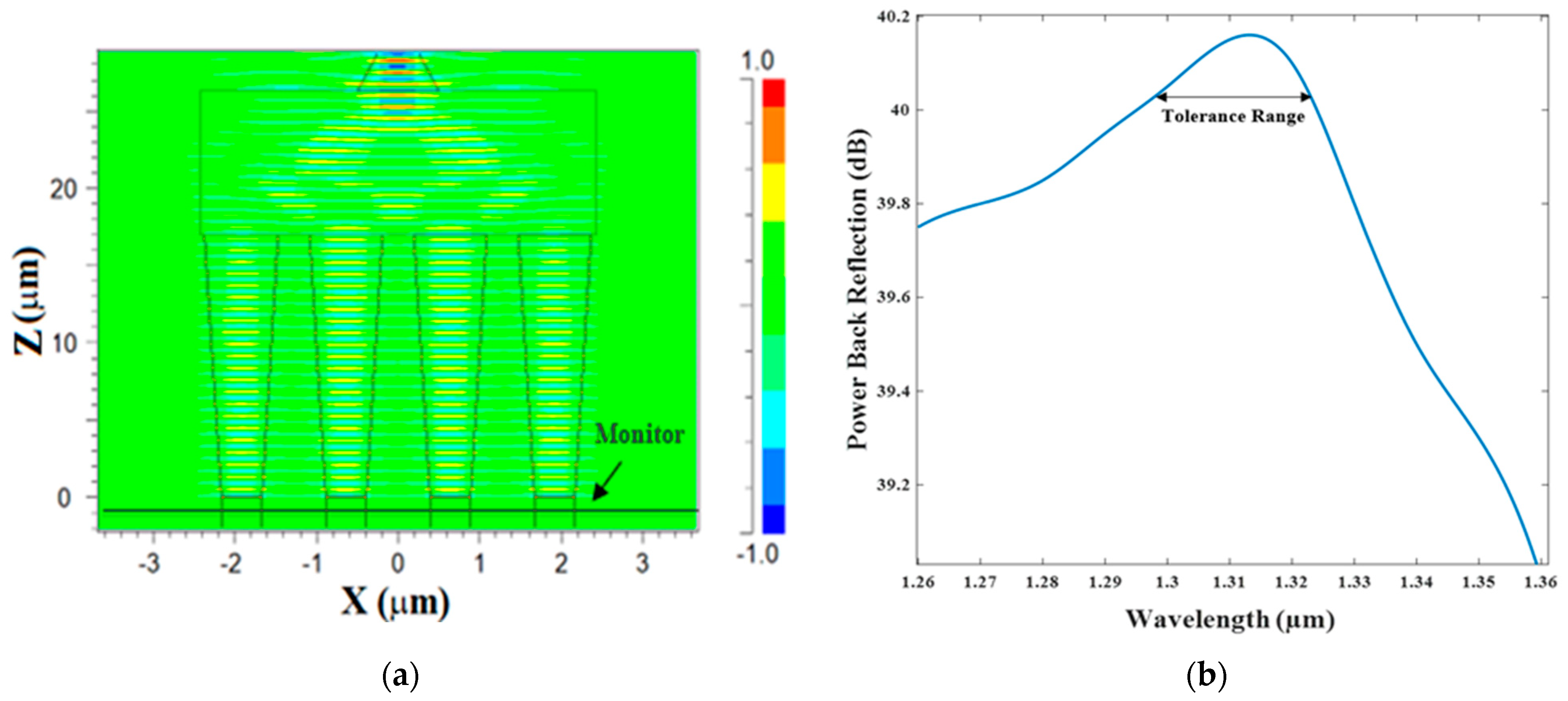
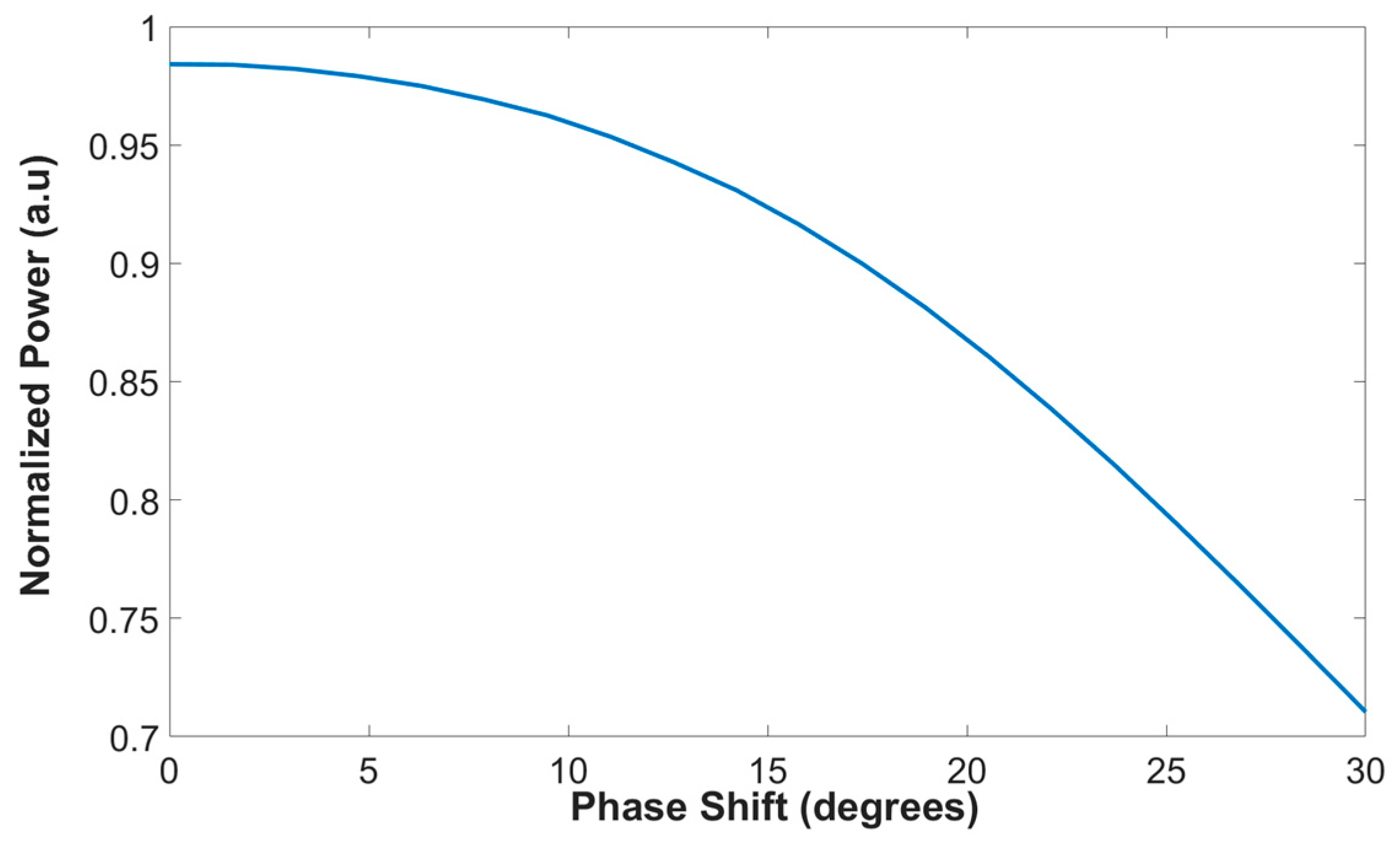
| Waveguide Combiner Type | Dimension (mm) (Length × Width) | Number of Inputs Sources | Operation Spectrum Band | Insertion Loss (dB) | BR (dB) | Year of Publication |
|---|---|---|---|---|---|---|
| MMI using Si slot waveguide [34] | 0.00982 × 0.0035 | 3 | C-band | ~0.088 | 33.25 | 2020 |
| MMI using InP/InGaAsP waveguide [39] | 1.72 × 0.006 | 2 | O-band | ~0.78 | NA | 2015 |
| MMI based on Si3N4 slot waveguide | 0.028 × 0.0048 | 4 | O-band | ~0.07 | 40.15 | This work |
Publisher’s Note: MDPI stays neutral with regard to jurisdictional claims in published maps and institutional affiliations. |
© 2022 by the authors. Licensee MDPI, Basel, Switzerland. This article is an open access article distributed under the terms and conditions of the Creative Commons Attribution (CC BY) license (https://creativecommons.org/licenses/by/4.0/).
Share and Cite
Katash, N.; Khateeb, S.; Malka, D. Combining Four Gaussian Lasers Using Silicon Nitride MMI Slot Waveguide Structure. Micromachines 2022, 13, 1680. https://doi.org/10.3390/mi13101680
Katash N, Khateeb S, Malka D. Combining Four Gaussian Lasers Using Silicon Nitride MMI Slot Waveguide Structure. Micromachines. 2022; 13(10):1680. https://doi.org/10.3390/mi13101680
Chicago/Turabian StyleKatash, Netanel, Salman Khateeb, and Dror Malka. 2022. "Combining Four Gaussian Lasers Using Silicon Nitride MMI Slot Waveguide Structure" Micromachines 13, no. 10: 1680. https://doi.org/10.3390/mi13101680
APA StyleKatash, N., Khateeb, S., & Malka, D. (2022). Combining Four Gaussian Lasers Using Silicon Nitride MMI Slot Waveguide Structure. Micromachines, 13(10), 1680. https://doi.org/10.3390/mi13101680






